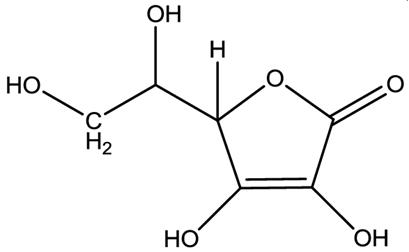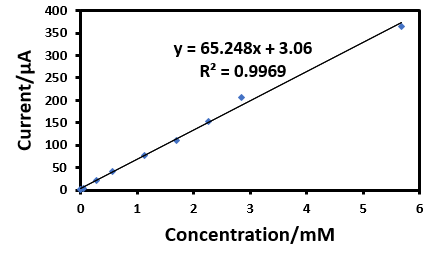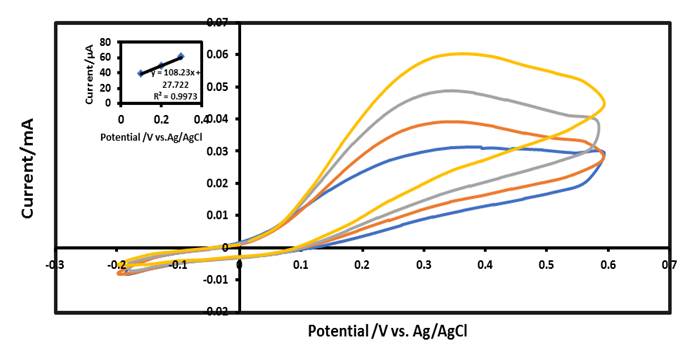Introduction
L-ascorbic acid (C6H8O6) is the trivial name of Vitamin C, scheme 1, considered one of the essential water-soluble vitamins for human health. It is found in various biological systems and fresh foodstuff (1). The human body required ascorbic acid for normal physiological functions such as the synthesis and metabolism of tyrosine, folic acid, and tryptophan (2). At the same time, ascorbic acid deficiency is associated with many diseases such as anemia infections and scurvy (3).
Additionally, synthetic ascorbic acid is available in several types of supplements such as tablets, capsules, chewable tablets, crystalline powder, effervescent tablets, and liquid forms (4). Several methods have been reported in the literature for the quantitative determination of ascorbic acid in various matrices. These methods include chromatography (5,6), titration (7), spectroscopy (8-12), fluorimetry (13), and flow injection analysis (14). However, some of the reported methods are time-consuming, and some are expensive and need skilled personnel.
Alternatively, electrochemical methods are considered a promised methods because of the short time response, low cost, sensitivity, and simplicity of instrumentation (15).
The modification of electrode surface is a quest to render electrochemical function that is not possible or difficult to achieve by using conventional electrodes. The goals of the improvement process include increasing selectivity, sensitivity, chemical and electrochemical stability, large usable potential window, and improving resistance to fouling (contaminating) (16).
Therefore, the avenues have opened toward the modification of solid electrodes (17). For instance, adsorbed iodine on platinum electrode surface enhances voltammetry’s reproducibility and simplifies background behavior (18). Also, coating of solid electrodes surface alters the kinetics and mechanisms of reactions run at the electrode surface. Iodine is one of the anions adsorbed to an electrode surface. The chemisorption process is achieved in two ways; from solution or vacuum to form stable chemisorbed monolayers; subsequently, the iodine-coated electrode is rinsed or evacuated (19). The iodine is adsorbed at potential 0.2 V vs. Ag/AgCl or SCE reference electrodes (20), which is the double layer potential. At the surface of the polycrystalline platinum electrode, the reaction of the iodine anions from the solution leads to spontaneous chemisorption of iodide anion to form stable neutral iodine atoms accompanied by an evolution of hydrogen gas. The adsorbed iodine is less reactive toward electrochemical oxidation than the free iodine anion in solution (21) and depends on the electrode potential (22). The chemisorbed iodine could be desorbed from the platinum electrode surface if the potential scanned is lower than -0.2 V, reducing of hydrogen ions and hydrogen gas generation (21). Also, the rate of iodine desorption from the electrode surface increases as the potential becomes more negative (22). In the positive direction, the chemisorbed iodine begins to desorb at a potential of 1.0 V (20). Studies have shown that carbon monoxide (CO) completely desorbed iodine from platinum electrode surface at potentials lower than 0.35 V, while at higher potentials, the desorption is incomplete (23).
Iodine-coated platinum electrode has been applied for the electrochemical determination of organic and non-organic species in many studies (24-32). Iodine-coated platinum electrode is characterized by the simplicity in preparation, application, and use of environmentally friendly chemical reagents. The simplicity of the method’s instrumentation stimulates our interest in this research. This work develops a simple method for ascorbic acid determination in pharmaceutical formulations.
Experimental
Materials and apparatus
A potentiostat (PAR Model 362, EG & G) interfaced to a computer via a GPIB interface (IEEE) data acquisition was used. Locally modified Labview® (IEEE) software was used for data acquisition. A one-compartment electrochemical cell with one inlet/outlet for gas purging and blanketing with oxygen-free nitrogen was used. The working electrode was a 0.5 mm polycrystalline platinum wire purchased from Aldrich (99.99% minimum purity certified reagent). The immersed end of the platinum electrode was curved at the end to a U-shape to mark for a constant surface area of the immersed part of the electrode. A silver/silver chloride was used as a quasi-reference electrode (QRE). The auxiliary electrode was a 0.5 mm polycrystalline platinum wire (Aldrich, certified 99.99% minimum purity). All reagents used were analytical grade and used as received from the suppliers without further purification. Sulfuric acid (95-97%) was supplied from Merck, L-ascorbic acid (99%) was purchased from AnalaR, potassium iodide was purchased from Sigma-Aldrich. Ultra-pure water, Millipore-MilliQ system was used for the preparation of all solutions. The N2 gas was a five grade, 99.999% minimum purity supplied from the International Jordanian Gases Company (Amman, Jordan).
Preparation of iodine-coated platinum electrode
The polycrystalline platinum electrode was cleaned with a freshly prepared chromic acid (H2CrO4), followed by rinsing with Millipore-Q water and sonicated for 10 minutes. After that, the platinum electrode was placed in contact with a supporting electrolyte solution of 0.5 M H2SO4 and conditioned between -0.25V and 1.3V until obtaining a reproducible cyclic voltammogram of a polycrystalline platinum electrode, which manifests the cleanliness of the electrode surface and electrochemical cell contents (Fig.1).
After cleaning the platinum electrode, the electrode was immersed in a supporting electrolyte containing 0.5 M H2SO4 + 0.01 M KI for five minutes under open-circuit conditions to complete the coating of the platinum electrode surface with iodine. Then the electrode was rinsed with water and 0.5M H2SO4 solution extensively. After the coating step, the electrode was cycled in a supporting electrolyte solution between -0.2V and +0.8V at a scan rate of 50 mV/s (Fig.1). The absence of oxygen and hydrogen adsorption/desorption features provides clear evidence for the complete coverage of the platinum electrode surface with a monolayer of iodine.
Sample preparation
The pharmaceutical formulation samples were purchased from local Jordanian pharmacies in the form of tablets and capsules. Three brands of pharmaceutical preparations were analyzed for their ascorbic acid content. The capsules of each sample were dissolved in 20 mL of 0.1 M KCl and sonicated for 10 min and left to equilibrate for 30 min. The solution was transferred to a 100 mL volumetric flask and filled to the mark with 0.1 M KCl. The solution was diluted to a concentration that matches the established calibration curve. A tablet of each sample was treated separately. The tablet of each brand was powdered using porcelain mortar and dissolved in 100.00 mL of the supporting electrolyte, 0.1 M KCl; the solution of the prepared samples was sonicated for 5 min and left to equilibrate for 5 min. A 5 mL aliquot of this solution was diluted to 50.00 mL with 0.1 M KCl to match the constructed calibration curve at different concentration ranges. A 10.00 mL of the diluted solution was placed in the electrochemical cell. The solution was bubbled with nitrogen gas (5G purity) and kept under a nitrogen gas atmosphere during the electrochemical experiment. The voltammetric analysis was conducted for ascorbic acid at the modified iodine-coated electrode within a potential window started at -0.2V and finished at 0.6V, where the adsorbed iodine is stable.
Results and discussions
Initially, a reproducible cyclic voltammogram for the polycrystalline platinum electrode, which indicates the cleanness of the electrochemical system, was obtained (Fig1-A). The process led to a successful coating process; the cyclic voltammogram of the iodine-coated platinum electrode between potential limits of -0.2V and 0.6V was displayed (Fig 1-B), where the adsorbed iodine was stable within this potential range. The complete absence of H2 and O2 oxidation-reduction features was the main indicator of a successful coated step.
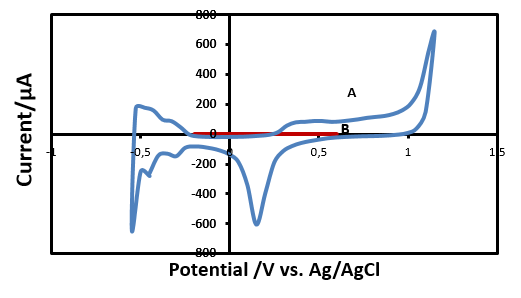
Fig.1. Cyclic voltammogramcurves of (A) polycrystalline platinum electrode and (B) the same electrode after adsorption of iodine from 0.01 M KI in 0.5 M H2SO4 solution
The effect of varying supporting electrolytes on the anodic peak current of ascorbic acid oxidation was investigated. A 0.5 M H2SO4 (pH=0.3), phosphate buffer of pH=3.5, and 0.1 M KCl (pH=7) solution were used. As displayed in Figure 2, various oxidation peak current was obtained for ascorbic acid oxidation with different supporting electrolyte solutions. The highest oxidation peak current was obtained in 0.5 M KCl (the highest pH value), 45.47±0.09 mV. Therefore, 0.1 M KCl solution was considered a supporting electrolyte in the following study.
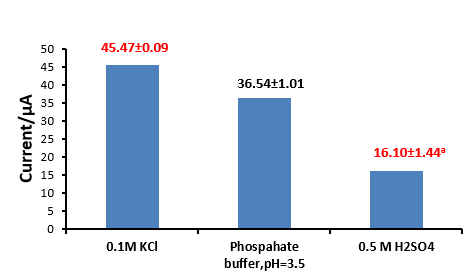
Fig.2. Effectof type of supporting electrolyte on the electrochemical signal of ascorbic acid at iodine-coated platinum electrode, Ascorbic acid; 0.57mM. Supporting electrolytes: H2SO4 0.5M (pH=0.3); phosphate buffer, pH=3.5; KCl 0.1M (pH=7) n=3; scan rate, 50 mV/sec. Numbers above the bars = mean±SD.
The effect of scan rate on the obtained anodic peak current of ascorbic acid was studied. As presented in Fig.3, there is a linear relationship between the square root of scan rate and oxidation peak current of ascorbic acid over the range of 10-100 mV/s, which suggested a diffusion-controlled irreversible oxidation process of ascorbic acid at the iodine-coated platinum electrode.
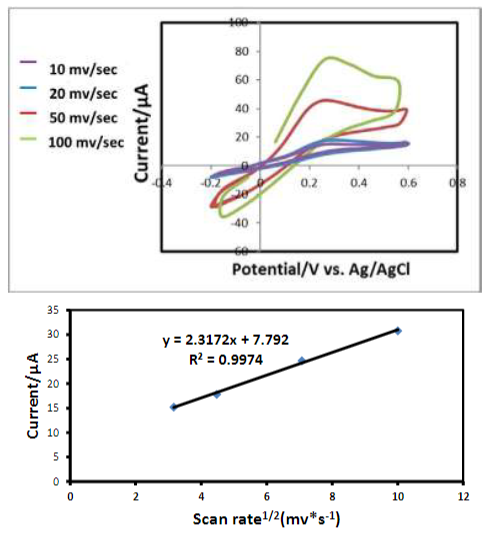
Fig 3. a) Cyclic voltammograms of iodine-coated platinum electrode in 0.1 M KCl and 50ppm of ascorbic acid recorded at 10, 20, 50, and 100 mv/s. b) The least square line for the ascorbic acid oxidation peak current vs. the square root of scan rate.
The obtained cyclic voltammograms for the iodine-coated platinum electrode in a series of ascorbic acid standard solutions show that the oxidation current increased steadily with ascorbic acid concentration (Fig.4). Three voltammograms were recorded for each standard solution. The anodic peak current was extracted for each cyclic voltammogram.
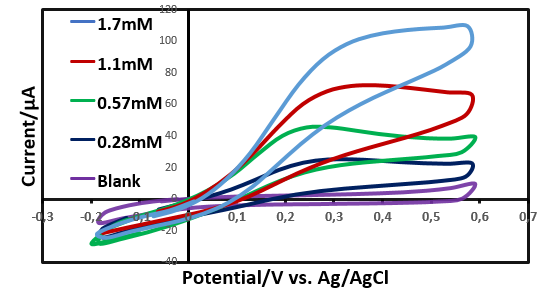
Fig 4 Cyclic voltammograms of iodine-coated platinum electrode in 0.1 M KCl solution containing 0.28, 0.57, 1.1, and 1.7 mM of ascorbic acid. All the scans were recorded at a scan rate of 50 mV/s.
Plotting the anodic peak current variation against ascorbic acid concentration gave a straight and extended dynamic range with concentrations ranging between 2.84 µM - 5.68 mM The calibration curve displayed in Fig 5 shows that all the variability of the response data around its mean; R2=0.9969, and the calibration equation is given by
Where I represents the anodic peak current which attributed to the ascorbic acid oxidation as it is shown in the following equation:
The precision, that is, the repeatability of the method, was assessed by extracting the anodic peak current of the recorded cyclic voltammograms for a solution containing 0.28 mM ascorbic acid. The achieved coefficient of variation for 10 successive measurements was 1.36%, indicating the high precision of the developed method.
The limit of detection based on the formula LOD=3.3Ϭ/S, and the limit of quantitation based on the formula LOQ=10Ϭ/S, where Ϭ represents the blank signal (background current), and S means the sensitivity of the calibration curve was calculated. The estimated limits were 1.0 µM and 3.01 µM, respectively. Thus, acceptable sensitivity of the applied voltammetric method with high precision was obtained. Higher sensitivity can be achieved by applying a more sensitive technique like differential pulse voltammetry (DPV). However, differential pulse voltammetry was not attempted because cyclic voltammetry provides satisfactory sensitivity for ascorbic acid determination in pharmaceutical formulations.
Potential interference
The influence of vitamins B1, B6, B1, folic acid, citric acid, sucrose, glucose, and zinc were investigated in order to verify the existence of matrix effects of vitamin C capsules and multivitamins tablets on ascorbic acid determination using cyclic voltammetry. The recorded cyclic voltammograms for each of these compounds show the absence of any electrochemical response of iodine-coated platinum electrodes toward these compounds. Figure 6 shows the recorded voltammograms for a solution of Multivitamin sample (control) and after each addition of a known concentration of the ascorbic acid standard solution. The result proved the absence of any possible interference with ascorbic acid despite the various components included in the Multivitamin sample, Vitamin E, B1, B2, B6, Folic acid, Pantothenic acid, Biotin, and Niacin.
Recovery
The recovery experiment can be taken as evidence for the absence of interference. The feasibility of the developed voltammetric method for ascorbic acid determination was tested for three pharmaceutical formulation samples. Ascorbic acid standards of known concentration, 50 ppm and 60 ppm, were spiked into samples of tablet solutions in order to evaluate the percentage recovery for each brand of ascorbic acid. As listed in Table 1, the recovery values were found between 98.93±2.78 and 99.98±5.20 for all samples of ascorbic acid brands, showing the appropriateness of the iodine-coated platinum electrode for the quantitative analysis of ascorbic acid in pharmaceutical formulations.
Table 1 Recoveries of ascorbic acid from spiked pharmaceutical formulations obtained by the developed method
| % Recovery | Detected ascorbic acid after addition (mM), | Spiked ascorbic acid (mM) | Content of ascorbic acid (mM) | Samples |
| 99.98±5.20 | 0.51 | 0.227 | 0.28 | Vitamin C plus® |
| 98.93±2.78 | 0.51 | 0.227 | 0.28 | Multivit+® |
| 99.80±2.50 | 0.787 | 0.341 | 0.568 | Vitamin C 1000® |
Pharmaceutical preparation analysis
The developed voltammetric method was applied to analyze ascorbic acid in three brands of the pharmaceutical formulation, multivitamin tablets, and two brands of vitamin C capsules (Vito + multivitamin, vitamin C plus, and vitamin C 1000). The standard addition method was applied to a diluted sample analysis to avoid the matrix effect. The evaluation of ascorbic acid concentration was found to be more suitable with the aid of a calibration graph. The results for the analysis of these pharmaceutical formulations with the developed voltammetric method are given in Table 2.
The obtained results by applying a cyclic voltammetry technique at iodine-coated platinum electrode were compared with the labeled values claimed by manufacturers. The data displayed in table 1 show that all nominal values are within the 95% confidence interval, which indicates the evident absence of errors in the results. The relative errors of the analysis of the three types of pharmaceutical formulations were lower than 5%, which attests to the accuracy of the developed method. The measured coefficient of variation values (0.55-2.19%) was considered obvious evidence of the precision of the developed method. The paired t-test was used to examine the significant difference at 95% confidence level between the labeled values and the obtained results determined by the developed voltammetric method. Comparing the calculated t value (0.0039) with the critical t value (4.30 at p=0.05) (33), it is shown that this result supported the null hypothesis and indicated no significant difference between the values determined by the voltammetric method and the nominal value obtained from manufacturers.
Table.2 Ascorbicacid (Vitamin C) content in pharmaceutical formulations collected from the Jordanian local pharmacies as determined by cyclic voltammetry at iodine-coated platinum electrode.
| Pharmaceutical preparation | Nominal mass(in mg of ascorbic acid/capsule or tablet) | Average of determined mass(in mg) of ascorbic acid/capsule or tablet(n=3) | Standard deviation | 95% confidence limits | Relative error | Coefficient of variation |
| Vitamin C plus® | 500 | 497.42 | 3.18 | 497.42± 7.90 | 0.516 | 0.64% |
| Multivitamin+® | 60 | 60.32 | 1.32 | 60.31± 3.28 | 0.53 | 2.19% |
| Vitamin C1000® | 1000 | 997.53 | 5.48 | 997.531± 13.61 | 0.247 | 0.55% |
A comparison between the developed voltammetric method and some of the common analytical and voltammetric methods for ascorbic acid determination in terms of detection limit and the linear range was displayed in Table 2 3. As shown, the iodine-coated platinum electrode exhibited a lower detection limit than that of other voltammetric methods (29-31) (34-36). In contrast, the obtained linear range was convenient and extended compared to other voltammetric methods. Also, the developed method has the advantages of simplicity in sample preparations and analysis, side by side with a short time of analysis and the low price of instrumentations compared with other methods (Table 3).
Table. 3 A comparison of analytical performance of developed voltammetric method using iodine-coated platinum electrode with other analytical methods reported in literature
| Method | Linear range | Detection Limit(ppm) | Reference |
| HPLC | 56.78 µM-0.57 mM | 1.7x10-4 mM | [5] |
| Spectrophotometry | Method A:3.69 µM-63.59 µM Method B:2.9 µM-90.85 µM | Method A=0.85 µM, Method B=1.1 µM | [4] |
| Fluorometry | 0.7 µM-6.02 µM | 0.23 µM | [13] |
| Cyclic voltammetry | 0.01 mM-0.101 mM | 1.76 µM | [34] |
| Differential pulse voltammetry | 19.0 µM-0.21 mM | 19.0 µM | [35] |
| Square-wave voltammetry | - | 1.87 µM | [36] |
| Voltammetry | 2.84 µM - 5.68 mM | 0.96 µM | This work |
Conclusion
In this work, a successive use of an iodine-coated platinum electrode to determine ascorbic acid was achieved. The developed method excludes any sophisticated procedures. In contrast, it is considered an applicable method for simplicity of analysis procedures. The reported extended dynamic range 2.84x10-3 - 5.68 mM of ascorbic acid supports the applicability of the voltammetric method for ascorbic acid analysis in pharmaceutical products. Based on the recovery experiment, the absence of any interference from the other ingredients of pharmaceutical formulations is considered an evident indicator of the selectivity of the developed method. The statistical analysis of the results showed no significant difference between the values obtained from the voltammetric method and the labeled values claimed by the manufacturers.













